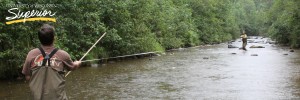 The pavement abruptly turned into a gravel road. The road soon turned onto an ATV trail that narrowed until finally coming to a ford on the Iron River just north of Oulu, Wisconsin.
The pavement abruptly turned into a gravel road. The road soon turned onto an ATV trail that narrowed until finally coming to a ford on the Iron River just north of Oulu, Wisconsin.
There, the team of scientists and student employees from the Lake Superior Research Institute at UW-Superior parked their van, pulled on their waders, gathered their equipment and began slogging up the river between its heavily wooded banks.
For the next several hours they carefully measured the river’s health and noted its characteristics: What is the quality of the water? What insects and aquatic worms live there? What’s on the bottom, rock or sediment? What plants live in the water and on the stream banks?
LSRI scientists are gathering the information as part of a three-year project to monitor the condition of coastal wetlands, tributaries and near-shore waters of Lake Superior in northwestern Wisconsin. Their work is funded by the Great Lakes Restoration Initiative, an Environmental Protection Agency program to fund projects that address the most important Great Lakes priorities, including habitat and wildlife protection and restoration, coastal wetland assessment, restoring the Great Lakes Areas of Concern, and keeping out invasive species.
For the LSRI scientists, the monitoring enables them to establish a record of the quality of water feeding the world’s greatest freshwater lake.
“We’re monitoring the conditions of coastal wetlands and the conditions of the streams feeding them,” said Amy Eliot, an associate researcher at LSRI who’s overseeing the monitoring effort. “We want to know if the quality of the water draining into the wetland is having any kind of an impact on Lake Superior.”
For the UW-Superior students working with Eliot, the project is an opportunity to gain experience in field work and analysis.
“It gives students a great opportunity to do field research, which is pretty nice in an undergraduate program to be able to do that,” Eliot said. “They work hard – get up early; it may be wet, it may be cold, but they’re troupers about doing the work.”
This is LSRI’s second field season of work on the Great Lakes Restoration Initiative grant.
Last summer and fall, the researchers worked with the Wisconsin Department of Natural Resources to set up coastal wetland monitoring sites along the shore of Lake Superior.
This season, the researchers are again taking samples from the coastal wetland sites while also setting up off-shore monitoring sites in Lake Superior and stream monitoring sites. The overall network of 71 monitoring sites stretches from the remote headwaters of the Little Pokegama River in Douglas County to Oronto Creek in Iron County near Wisconsin’s border with Michigan.
At the monitoring sites, the LSRI team conducts a thorough assessment of the environment: water quality, vegetation, and animal life. For the nearshore monitoring sites, water samples are sent to the DNR and also returned to LSRI labs for analysis.
At the stream monitoring sites, like the one on the Iron River near Oulu, the researchers take down a long list of observations:
- Quality of the water, including ph level, temperature, and nutrient levels.
- Physical characteristics, such as vegetation in the stream and type of river bottom.
- Aquatic life, including insects and aquatic worms.
At some sites the researchers also conduct a habitat assessment, which is a more detailed look that includes observations about the type of plants along the banks, whether eroded areas are present, the clarity of the water and how fast it’s flowing. All the information is collected following a strict standard of quality assurance.
The three-year monitoring program will provide scientists with a thorough understanding to the current conditions of the waters feeding Lake Superior.
“This provides us with a snapshot of current conditions,” Eliot said. “From here we can see resource changes and detect trends.”
In the future, scientists can return to the monitoring sites – each one is precisely located by GPS — to take additional readings. By comparing their data with today’s information, they’ll be able to spot trends that show how the lake is being affected by invasive species, climate change and other environmental factors.
The Lake Superior Research Institute at UW-Superior conducts environmental research and provides environmental education and public information for the Great Lakes region. It is funded primarily through grants and other external funding. Scientists and staff members associated with LSRI possess a wide range of expertise in chemistry, biology, toxicology, microbiology, geology, statistics, database management, data processing, computer programming, and geographic information systems. Many UW-Superior students participate in LSRI research as research assistants or interns.
